- Riksbank: wait, see and hope.
- Protect more bullish positions with a 2Y-5Y steepener.
- Play the flat SEK curve relative EUR by paying 2Y2Y spread.
- Updated levels on LFH519 ASW (Sep 2026) vs SHYP1588 ASW (Mar 2024).
- Are the Beatles giving SEK buyers a message ahead of the Riksbank?
- ECB: At the April Riksbank meeting, the guidance was ‘rate unchanged at least through 2019’. Since then the ECB has (1) extended its guidance to ‘at least through the first half of 2020 and later (2) opened up the way for a rate cut and possibly other measures.
- Fed: The available ‘dots’ pointed to no rate changes this year and one hike in 2020. Median dots now suggest a possible rate cut this year and no change in 2020.
- Bank of England: Governor Mark Carney recently underlined that risks of a no-deal Brexit have intensified and in the event of a no-deal exit, lower rates are more likely than the opposite.
Trades
New, pay SEK 2Y-5Y @ +19bp. P/L: +32bp/+10bp.
New, pay SEK 2Y2Y vs EUR @ +30bp. P/L: +45bp/+20bp.
Danske Bank’s market view in a nutshell

Riksbank: wait, see and hope
As late as April, the Riksbank decided to postpone the next rate hike and flatten the repo path. The timing of the second hike was described as late this year or early next year (presumably December or February), so is it time for a new shift?
The result of this weekend’s talks on trade between the American and Chinese presidents could play some role but the tremendous shift in policy guidance by other central banks is the big piece of new information. They have announced the following changes.
Market pricing has shifted quite significantly. Up to end-2020, the market is pricing in total Fed cuts of around 100bp, ECB cuts of around 15bp and Bank of England cuts of 10bp, etc. (see table below). Therefore, in our view, it is reasonable to believe that the forecast for international policy rates (weighted average of Fed, ECB, Bank of Norway and Bank of England – see chart) will be lowered significantly.

At the same time, domestic data do not necessarily warrant another softening of the policy stance as such. First-quarter GDP at 2.1% y/y was a good bit above expectations, although, in our opinion, the details revealed a much less upbeat picture, with domestic demand stagnating and the GDP number held up by a rather unconvincing jump in services exports.
However, inflation has largely been in line with forecasts and the new ‘favourite’ core measure (a median of a set of core inflation measures) is also at 2%. In the meantime, the latest quarterly Prospera inflation survey stayed close to 2%, although this is a notch lower than in the previous survey.
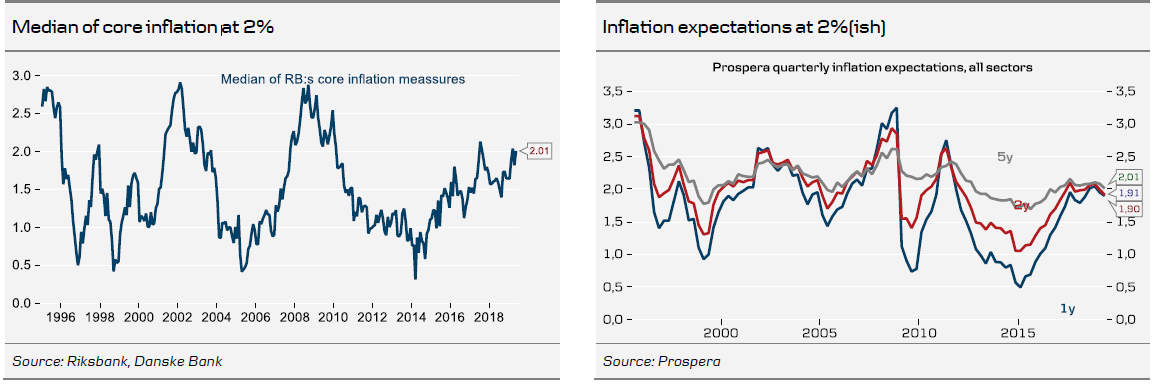
There is also evidence of an ongoing deceleration of growth. The latest confidence surveys show that consumers remain rather downbeat, business conditions in services are slightly below normal and manufacturers are well off peaks. Job market data have been mixed (or more precisely volatile) but the overall picture is that unemployment has been flat for about a year, while the steady rise in employment that has been going on since 2010 appears to have stopped.
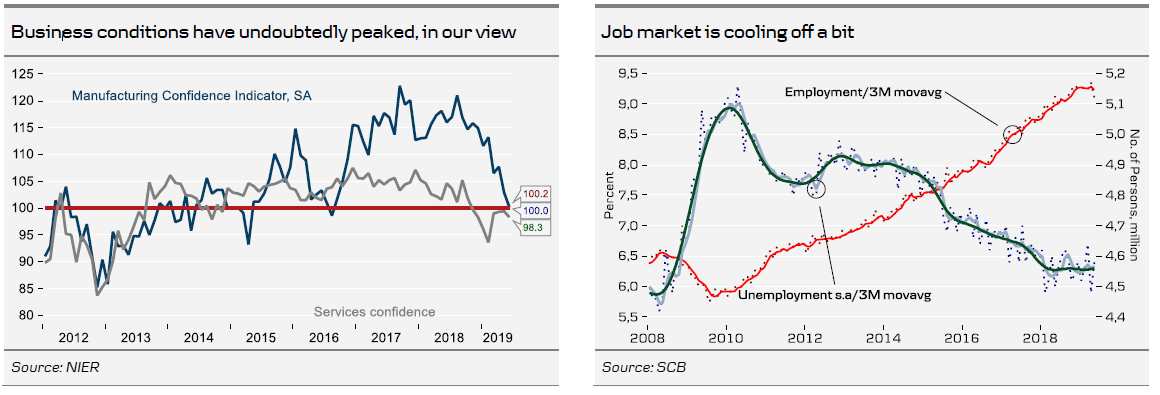
On the back of this, it would be odd to pretend that nothing has happened. However, it would not be the Riksbank’s style to announce a bigger policy shifty at this time. An elegant way would be for the Riksbank to drop the first part of the phrase ‘next hike late this year or early 2020’, a sort of verbal postponement. In the meantime, the Riksbank can sit back and see what other central banks actually do and how data unfold. Will it hike in 2020? We do not think so.
Protect more bullish positions with a 2Y-5Y steepener
Some of our trading recommendations have a bullish tilt, such as our short position in the SGBi3109 (May 2025) breakeven. This fits well with our main view of rates continuing to be under downward pressure over coming months, although the potential for lower rates looks to us more exhausted. At the same time, to reduce daily portfolio volatility, we like adding a more bearish trade to our list of recommendations.
We see the downside in the 5Y point as very limited. The 2-5Y slope trades at a historically stretched level (currently c.17bp), which we have not seen with a repo rate anywhere near current levels. The previous time we saw similar levels was in 2012, when 3M (NYSE:MMM) Stibor was c.2%. We do not believe the 2Y-5Y segment will invert given that it is difficult to see a sustained easing cycle with the current repo rate, which makes the potential outcomes for the position somewhat asymmetric.
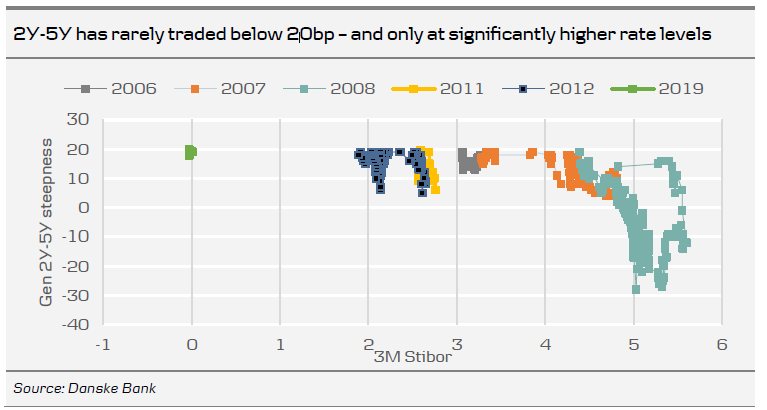
Moreover, the SEK yield curve convexity has now basically caught up with levels in EUR. In our view, it is difficult to make a case that levels should be lower in SEK, as the mediumterm outlook is still better for the Riksbank than it is for the ECB, given more robust fundamentals (substantially higher inflation, lower unemployment).
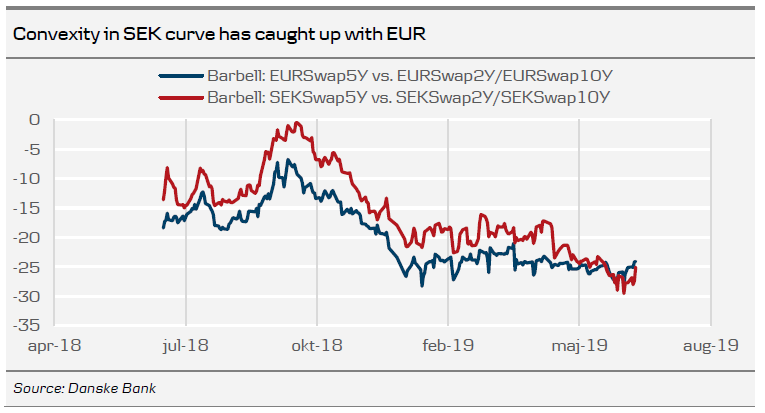
With current stretched levels, we think that the 5Y point would be very exposed if rates were to rebound. Therefore, we recommend adding a 2Y-5Y SEK swap steepener as a complement to our more bullish trade recommendations.
Play the flat SEK curve relative EUR by paying 2Y2Y spread
Since the Riksbank’s April meeting, we note that the 2Y2Y spread versus EUR has tightened. Surely, the decision was dovish relative to market expectations, with a lowered repo rate path in combination with the announcement of SEK45bn in QE reinvestments. Given this, the initial reaction to tighten the SEK against EUR made sense but since the initial reaction, the spread has continued to tighten. Explanations could be that the Swedish curve was more aggressively priced in terms of Riksbank hikes and that the recent shifts from the ECB and Fed have resulted in faded market expectations of the Riksbank. However, given the developments since April, we struggle to justify this move continuing much further from here.
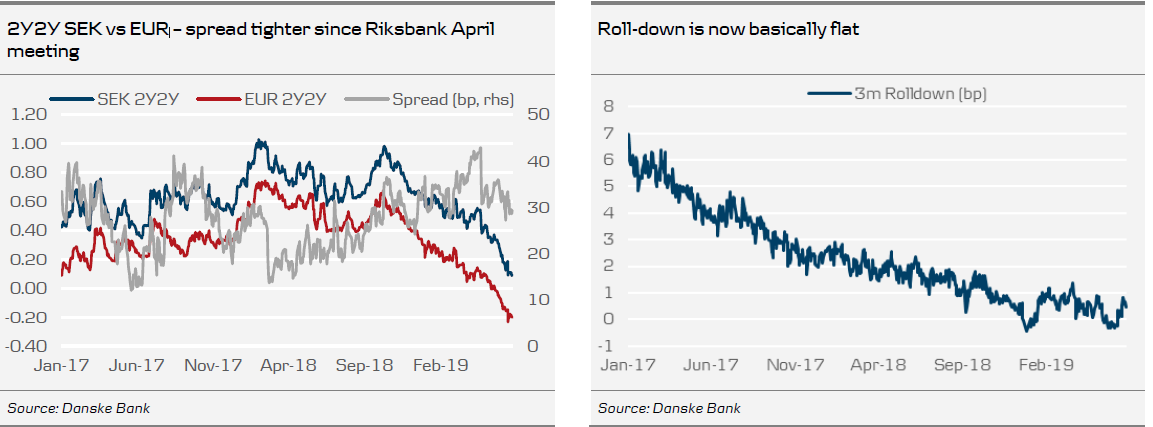
Swedish data has been surprisingly good, with, for example, both CPI for May and Q1 GDP beating market expectations. We expect both of these measures to slow down later this year but here and now we expect the Riksbank to lean on these numbers in the decision next week (see above) and we believe that we would need to see a sharp deterioration in hard data for the Riksbank to consider rate cuts seriously. Thus, we believe the Riksbank is unlikely to match the ECB’s dovishness. As we said above, the Swedish economy seems to us set to be more robust than that of the eurozone over the medium term. Mario Draghi’s speech in Sintra strongly signalled that further ECB easing is on the way and our colleagues in Copenhagen updated their call and now see a 20bp cut in September in combination with a tiering system, extended forward guidance and a restart of QE.
Given the relative flattening of the Swedish curve, partly explained by the Riksbank December 2018 hike, the negative carry and roll in paying SEK versus EUR have evaporated and for the 2Y2Y spread, it is now basically flat. Hence, given a flat curve in SEK relative to EUR in combination with our views on the Riksbank and ECB, we see good risk-reward in paying 2Y2Y SEK against EUR here. We enter the trade at +30bp, with P/L targets set at +45bp/+20bp.
Updated levels on LFH519 ASW (Sep 2026) vs SHYP1588 ASW (Mar 2024)
Our recommendation to buy LFH519 ASW (Sep 2026) versus SHYP1588 ASW (Mar 2024) has now reached our initial profit target of +15bp. However, we believe there may be some juice left in the trade, as the hunt for yield continues to intensify. From an historical perspective, the ASW curve for covered bonds is not particularly flat between 5Y and 7Y. Hence, we keep the trade on and move our P/L levels by 5bp to +10bp/+31bp.

Are the Beatles giving SEK buyers a message ahead of the Riksbank?
‘Oh I get by with a little help from friends, Mm I get high with a little help from my friends’– these lyrics by John Lennon/Paul McCartney hit our minds when Norges Bank went against the stream and not only pushed the NOK higher but also, after some consideration, sent the SEK to higher levels. If Norges Bank can, the Riksbank can too, right. Well, we do not think so. The lyrics continue: ‘What do I do when my love is away, (Does it worry you to be alone?), How do I feel by the end of the day, (Are you sad because you're on your own?)’. This sums up our view: at the end of the day, the SEK is on its own, in the hands of the Riksbank.
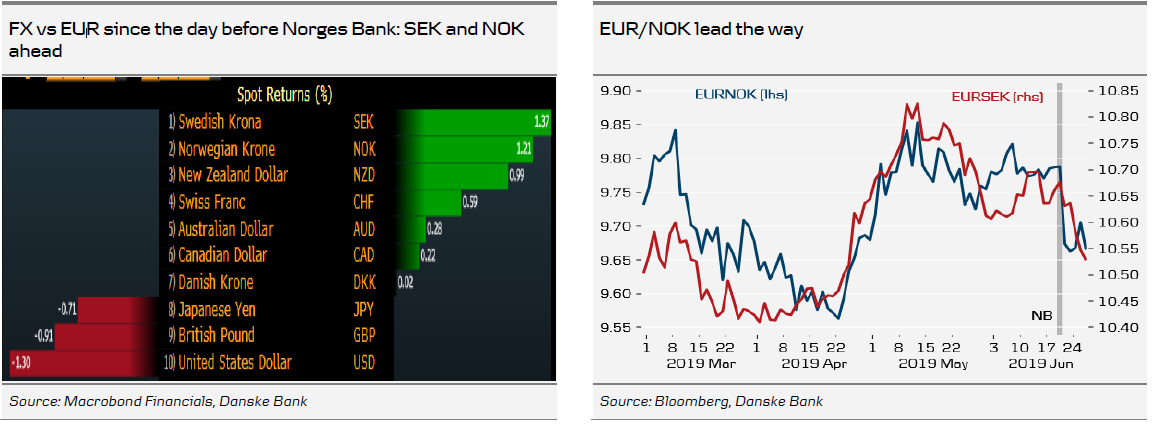
To be honest, Norges Bank should be of minor importance for the Riksbank next week. Instead, the Riksbank will probably pay much more attention to what is happening at the major central banks. First, the U-turn by the ECB, confirmed by Mr Draghi in Sintra last week, and, second, the Fed indicating rate cuts. A significant repricing has taken place: from -2bp in 2019 before the Riksbank’s April meeting to -15bp today for the ECB and from -20bp then to -73bp today for the Fed. This should affect the Riksbank. Meanwhile, the US 10-year has fallen 50bp to 2.0% in a short period of time, which may have caused some investors to trim their carry positions. Another factor that has possibly contributed to recent days’ SEK appreciation is positive rebalancing flows among Swedish investors, given that the value of the foreign bond and equity portfolio has gone up.
Hence, we believe it is likely the Riksbank will not only remove the hike probability for 2019 but also delay the next hike by one or two quarters. Would such a decision be bearish for the SEK when the money market is already indicating cuts? We think so. Markets seem to drag central banks in one direction, as for the ECB and Fed over recent months and the Riksbank over recent years. One should interpret postponing the hikes now as taking a first dovish step, rather than clashing with expectations – especially if one agrees with our inflation outlook. We think the Riksbank will come across as dovish, which should weigh on the SEK (push EUR/SEK higher). One may argue that the upside potential is somewhat limited by already soft pricing. However, if contrary to our expectations, the Riksbank leaves the repo rate path intact, there could be a relatively big sell-off in EUR/SEK. Therefore, the downside risk in EUR/SEK if we are wrong should be bigger than the upside risk if we are right.
In April, the Riksbank surprised us all by lowering the rate path, which sent EUR/SEK 10 figures higher on the same day, then another 10 figures after a week and then yet another 10 figures after two weeks. While we expect it to lower the rate path next week, pricing/expectations were very different: +15bp for 2019 back then versus -4bp now, which suggests a less aggressive reaction this time. Our impression is that the currency market underestimates the potential in EUR/SEK in relation to the rate decision. The option market is currently pricing that day as more or less a normal day with an intra-day move of 4.5 figures. This is clearly lower than an average Riksbank day, though. Let uss have a look.
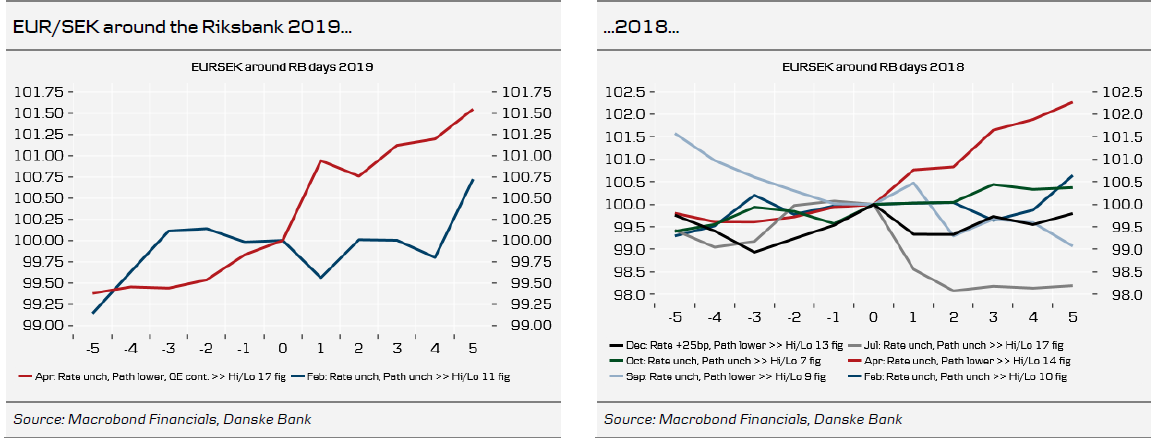

In 2018, the high/low spread on Riksbank days was 12 figures on average. The three times the Riksbank lowered its rate path, the intraday move was also 12 figures. In 2017, the average intraday move on Riksbank day was 8 figures but on those days when the Riksbank cut its repo rate path, the intraday move was a bit higher at 10 figures. In 2016, the high/low was 12 figures on an average Riksbank day but a considerable 20 figures the two times the bank cut its rate path. The ‘web charts’ above show how the EUR/SEK close developed five days before and after the rate announcement, with EUR/SEK set to 100 the day before the announcement. They also show what decisions were made and the high/low spread on the Riksbank day.
In all, there is no single year in our sample where EUR/SEK on average has moved as little as the option market is pricing for next week, i.e. 4.5 figures. Overall, the high/ low has been 11 figures and counting only the times when the Riksbank lowered its rate path (seven out of 20) the high/low is 15 figures. In this perspective, it looks attractive to buy volatility over the Riksbank day, with or without a directional view.
Open strategies
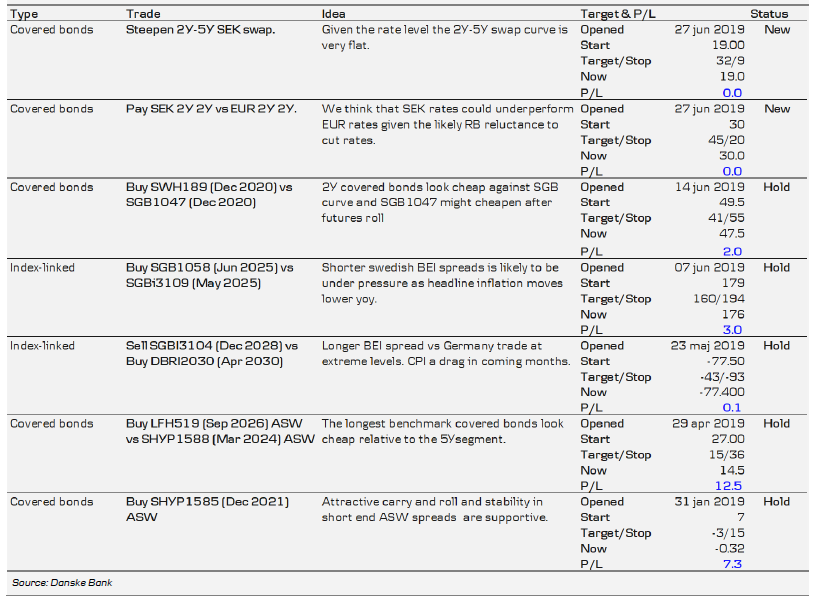
Upcoming Swedish data

